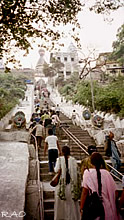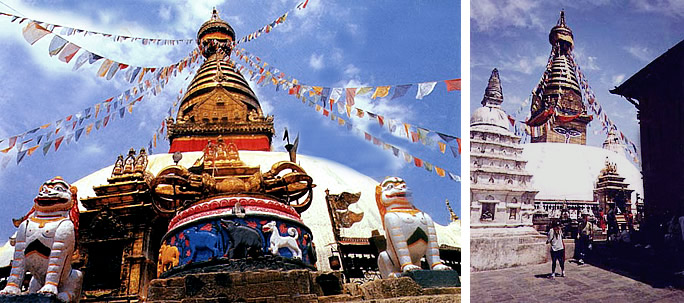|
Swayambhunath
- Swoyambhunath: Heritage Tour
|
|
Swoyambhu
Nath Stupa (Swoyambhunath)
|
Located
in a lovely little hill rock Swoyambhu Nath Stupa is one of the most fascinating
architectural jewels of the world. This great Stoup is said to have been built
around 250 B.C.
This
is believed to be 25 centuries old and stands as one of the world's oldest Buddhist
Chaityas (Stupa). The great Stupa of Swayambhu is the wonder that was
Nepal, the glory that was Nepal. It is indeed listed a world Heritage site
of Culture to prove that it serves as the nerve centre of faithful worship
for all the devout Buddhists of the universe. Swayambhu embraces the authentic
philosophy of Bajrayan in Particular and honour Lord Adi Buddha.
It is dedicated to self-originating flame god.
The Stupa, which
forms the salient structure, is well composed of a solid hemisphere of
terra-cotta bricks and soil supporting a cornice of copper and gilt. Painted
in the four-sided base of the spare are the all-seeing eyes of Lord
Buddha, keeping an eternal watch on the valley distinguishing between
vice and virtue. It is some 2 miles west of Kathmandu City, proper across
the holy Bishnumati River (Bagmati). Situated on the top of a hillock,
it is about 77m above the level of the valley.
The whole hill is a mosaic
of small Chaityas and Pagoda Temples possessing great dignity plus
beauty. There also exist six big Buddhist monasteries in all - 5 Mahayan
(Lamaist) and one Hinyan (Therbadist). On the hind hill is located
another important Buddhist shrine; it is called Manjushree. This
coMapssionate Chinese Buddha is the god of Knowledge.
Generally
a holy memorial site Stupa represents a typical Buddhist architecture.
Its main feature the white dome is identified with a spotless pure jewel
of Nirvana and a thirteen tiered golden spire in conical shape surmounted
on the dome. Underneath this towering structure are a pair of all seeing
eyes of Buddha painted on all four sides of the Stupa.
The Stupa
of Swoyambhunath stands on a typically stylized lotus mandala base-a
long time ago believed to have originated from a legendary lake of Kathmandu
Valley.
 |
| As
the ancient legend goes Kathmandu Valley was a lake a long time ago.
Right in the centre of this lake was a full blown lotus with the divine
light a top. When Maha Manjushri a saint from China heard about
this he came rushing all the way from China to the Valley. He cut through
the southern wall hill of the valley with his divine sword. The cleft made
by the sword immediately drained the entire lake water making the valley
floor open for a close up view of the divine lotus light.
This
holy site in fact is the massive stupa complex ever built in Nepal. Hundreds
of votive shrines and other historical monuments built in and around this
stupa speak a lot about the significance and antiquity of this famed stupa. |
|
The Stupa
of Swoyambhunath (Swayambunath) lies about 3km west of down town Kathmandu.
There
are two different ways to reach for this site. One is from the west side
which is relatively a short cut and another is from the east side where
it leads to the main entrance with 360 steps leading all the way
to the top, where the most venerated Swayambhu Stupa stands-commanding
a magnificent view of Kathmandu Valley and the breathtaking panorama of
the north eastern Himalayan range.
Other
important things to be seen here include a magnificent two tiered golden
temple dedicated to Harati. She is the grand mother deity of children and
small pox who was said to be the Ogress until Lord Buddha converted her
to be the great caretaker of the children.
Not
to far from this temple is Dewa Dharma monastery - noted for a bronze
icon of Buddha and traditional Tibetan paintings.
 |
Vajra
The
huge gold plated vajra, the priestly symbol of Vajrayana Buddhism, set on the Dharmadhatu mandala at the side of the stupa is worth
a close look. |
|
Important
days to visit this holy site:
1.
Buddha Purnima, the birth day of Lord Buddha which fails on the full moon
day of Baishak (April-May)
2.
Gunla the holy Buddhist month according to Newari calendar (Aug.-Sept.,
early Morning).
3.
Kojagrath Purni (Sept.-Oct.)
4.
Samyak day of the Magh (Jan.Feb.) (every twelve years)
| 



